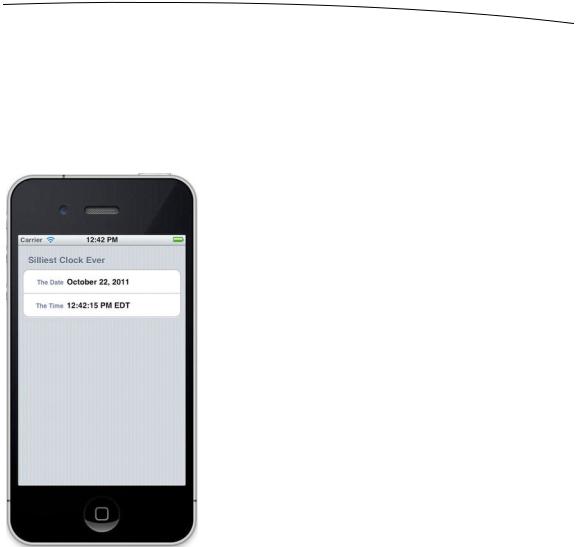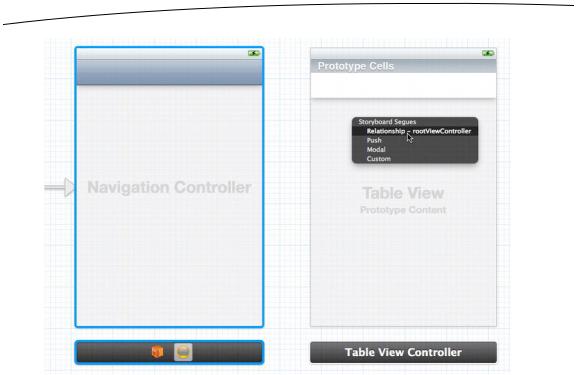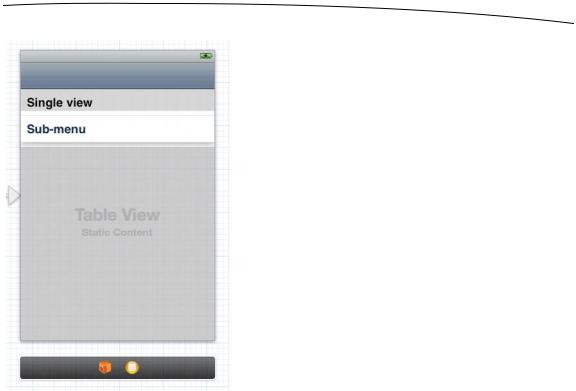
- •Contents at a Glance
- •About the Authors
- •About the Technical Reviewer
- •Acknowledgments
- •Preface
- •What This Book Is
- •What You Need
- •Developer Options
- •What You Need to Know
- •What’s Different About Coding for iOS?
- •Only One Active Application
- •Only One Window
- •Limited Access
- •Limited Response Time
- •Limited Screen Size
- •Limited System Resources
- •No Garbage Collection, but…
- •Some New Stuff
- •A Different Approach
- •What’s in This Book
- •What’s New in This Update?
- •Are You Ready?
- •Setting Up Your Project in Xcode
- •The Xcode Workspace Window
- •The Toolbar
- •The Navigator View
- •The Jump Bar
- •The Utility Pane
- •Interface Builder
- •New Compiler and Debugger
- •A Closer Look at Our Project
- •Introducing Xcode’s Interface Builder
- •What’s in the Nib File?
- •The Library
- •Adding a Label to the View
- •Changing Attributes
- •Some iPhone Polish—Finishing Touches
- •Bring It on Home
- •The Model-View-Controller Paradigm
- •Creating Our Project
- •Looking at the View Controller
- •Understanding Outlets and Actions
- •Outlets
- •Actions
- •Cleaning Up the View Controller
- •Designing the User Interface
- •Adding the Buttons and Action Method
- •Adding the Label and Outlet
- •Writing the Action Method
- •Trying It Out
- •Looking at the Application Delegate
- •Bring It on Home
- •A Screen Full of Controls
- •Active, Static, and Passive Controls
- •Creating the Application
- •Implementing the Image View and Text Fields
- •Adding the Image View
- •Resizing the Image View
- •Setting View Attributes
- •The Mode Attribute
- •Interaction Checkboxes
- •The Alpha Value
- •Background
- •Drawing Checkboxes
- •Stretching
- •Adding the Text Fields
- •Text Field Inspector Settings
- •Setting the Attributes for the Second Text Field
- •Creating and Connecting Outlets
- •Closing the Keyboard
- •Closing the Keyboard When Done Is Tapped
- •Touching the Background to Close the Keyboard
- •Adding the Slider and Label
- •Creating and Connecting the Actions and Outlets
- •Implementing the Action Method
- •Adding Two Labeled Switches
- •Connecting and Creating Outlets and Actions
- •Implementing the Switch Actions
- •Adding the Button
- •Connecting and Creating the Button Outlets and Actions
- •Implementing the Segmented Control Action
- •Implementing the Action Sheet and Alert
- •Conforming to the Action Sheet Delegate Method
- •Showing the Action Sheet
- •Spiffing Up the Button
- •Using the viewDidLoad Method
- •Control States
- •Stretchable Images
- •Crossing the Finish Line
- •The Mechanics of Autorotation
- •Points, Pixels, and the Retina Display
- •Autorotation Approaches
- •Handling Rotation Using Autosize Attributes
- •Configuring Supported Orientations
- •Specifying Rotation Support
- •Designing an Interface with Autosize Attributes
- •Using the Size Inspector’s Autosize Attributes
- •Setting the Buttons’ Autosize Attributes
- •Restructuring a View When Rotated
- •Creating and Connecting Outlets
- •Moving the Buttons on Rotation
- •Swapping Views
- •Designing the Two Views
- •Implementing the Swap
- •Changing Outlet Collections
- •Rotating Out of Here
- •Common Types of Multiview Apps
- •The Architecture of a Multiview Application
- •The Root Controller
- •Anatomy of a Content View
- •Building View Switcher
- •Creating Our View Controller and Nib Files
- •Modifying the App Delegate
- •Modifying BIDSwitchViewController.h
- •Adding a View Controller
- •Building a View with a Toolbar
- •Writing the Root View Controller
- •Implementing the Content Views
- •Animating the Transition
- •Switching Off
- •The Pickers Application
- •Delegates and Data Sources
- •Setting Up the Tab Bar Framework
- •Creating the Files
- •Adding the Root View Controller
- •Creating TabBarController.xib
- •The Initial Test Run
- •Implementing the Date Picker
- •Implementing the Single-Component Picker
- •Declaring Outlets and Actions
- •Building the View
- •Implementing the Controller As a Data Source and Delegate
- •Implementing a Multicomponent Picker
- •Declaring Outlets and Actions
- •Building the View
- •Implementing the Controller
- •Implementing Dependent Components
- •Creating a Simple Game with a Custom Picker
- •Writing the Controller Header File
- •Building the View
- •Adding Image Resources
- •Implementing the Controller
- •The spin Method
- •The viewDidLoad Method
- •Final Details
- •Linking in the Audio Toolbox Framework
- •Final Spin
- •Table View Basics
- •Table Views and Table View Cells
- •Grouped and Plain Tables
- •Implementing a Simple Table
- •Designing the View
- •Writing the Controller
- •Adding an Image
- •Using Table View Cell Styles
- •Setting the Indent Level
- •Handling Row Selection
- •Changing the Font Size and Row Height
- •Customizing Table View Cells
- •Adding Subviews to the Table View Cell
- •Creating a UITableViewCell Subclass
- •Adding New Cells
- •Implementing the Controller’s Code
- •Loading a UITableViewCell from a Nib
- •Designing the Table View Cell in Interface Builder
- •Using the New Table View Cell
- •Grouped and Indexed Sections
- •Building the View
- •Importing the Data
- •Implementing the Controller
- •Adding an Index
- •Implementing a Search Bar
- •Rethinking the Design
- •A Deep Mutable Copy
- •Updating the Controller Header File
- •Modifying the View
- •Modifying the Controller Implementation
- •Copying Data from allNames
- •Implementing the Search
- •Changes to viewDidLoad
- •Changes to Data Source Methods
- •Adding a Table View Delegate Method
- •Adding Search Bar Delegate Methods
- •Adding a Magnifying Glass to the Index
- •Adding the Special Value to the Keys Array
- •Suppressing the Section Header
- •Telling the Table View What to Do
- •Putting It All on the Table
- •Navigation Controller Basics
- •Stacky Goodness
- •A Stack of Controllers
- •Nav, a Hierarchical Application in Six Parts
- •Meet the Subcontrollers
- •The Disclosure Button View
- •The Checklist View
- •The Rows Control View
- •The Movable Rows View
- •The Deletable Rows View
- •The Editable Detail View
- •The Nav Application’s Skeleton
- •Creating the Top-Level View Controller
- •Setting Up the Navigation Controller
- •Adding the Images to the Project
- •First Subcontroller: The Disclosure Button View
- •Creating the Detail View
- •Modifying the Disclosure Button Controller
- •Adding a Disclosure Button Controller Instance
- •Second Subcontroller: The Checklist
- •Creating the Checklist View
- •Adding a Checklist Controller Instance
- •Third Subcontroller: Controls on Table Rows
- •Creating the Row Controls View
- •Adding a Rows Control Controller Instance
- •Fourth Subcontroller: Movable Rows
- •Creating the Movable Row View
- •Adding a Move Me Controller Instance
- •Fifth Subcontroller: Deletable Rows
- •Creating the Deletable Rows View
- •Adding a Delete Me Controller Instance
- •Sixth Subcontroller: An Editable Detail Pane
- •Creating the Data Model Object
- •Creating the Detail View List Controller
- •Creating the Detail View Controller
- •Adding an Editable Detail View Controller Instance
- •But There’s One More Thing. . .
- •Breaking the Tape
- •Creating a Simple Storyboard
- •Dynamic Prototype Cells
- •Dynamic Table Content, Storyboard-Style
- •Editing Prototype Cells
- •Good Old Table View Data Source
- •Will It Load?
- •Static Cells
- •Going Static
- •So Long, Good Old Table View Data Source
- •You Say Segue, I Say Segue
- •Creating Segue Navigator
- •Filling the Blank Slate
- •First Transition
- •A Slightly More Useful Task List
- •Viewing Task Details
- •Make More Segues, Please
- •Passing a Task from the List
- •Handling Task Details
- •Passing Back Details
- •Making the List Receive the Details
- •If Only We Could End with a Smooth Transition
- •Split Views and Popovers
- •Creating a SplitView Project
- •The Storyboard Defines the Structure
- •The Code Defines the Functionality
- •The App Delegate
- •The Master View Controller
- •The Detail View Controller
- •Here Come the Presidents
- •Creating Your Own Popover
- •iPad Wrap-Up
- •Getting to Know Your Settings Bundle
- •The AppSettings Application
- •Creating the Project
- •Working with the Settings Bundle
- •Adding a Settings Bundle to Our Project
- •Setting Up the Property List
- •Adding a Text Field Setting
- •Adding an Application Icon
- •Adding a Secure Text Field Setting
- •Adding a Multivalue Field
- •Adding a Toggle Switch Setting
- •Adding the Slider Setting
- •Adding Icons to the Settings Bundle
- •Adding a Child Settings View
- •Reading Settings in Our Application
- •Retrieving User Settings
- •Creating the Main View
- •Updating the Main View Controller
- •Registering Default Values
- •Changing Defaults from Our Application
- •Keeping It Real
- •Beam Me Up, Scotty
- •Your Application’s Sandbox
- •Getting the Documents Directory
- •Getting the tmp Directory
- •File-Saving Strategies
- •Single-File Persistence
- •Multiple-File Persistence
- •Using Property Lists
- •Property List Serialization
- •The First Version of the Persistence Application
- •Creating the Persistence Project
- •Designing the Persistence Application View
- •Editing the Persistence Classes
- •Archiving Model Objects
- •Conforming to NSCoding
- •Implementing NSCopying
- •Archiving and Unarchiving Data Objects
- •The Archiving Application
- •Implementing the BIDFourLines Class
- •Implementing the BIDViewController Class
- •Using iOS’s Embedded SQLite3
- •Creating or Opening the Database
- •Using Bind Variables
- •The SQLite3 Application
- •Linking to the SQLite3 Library
- •Modifying the Persistence View Controller
- •Using Core Data
- •Entities and Managed Objects
- •Key-Value Coding
- •Putting It All in Context
- •Creating New Managed Objects
- •Retrieving Managed Objects
- •The Core Data Application
- •Designing the Data Model
- •Creating the Persistence View and Controller
- •Persistence Rewarded
- •Managing Document Storage with UIDocument
- •Building TinyPix
- •Creating BIDTinyPixDocument
- •Code Master
- •Initial Storyboarding
- •Creating BIDTinyPixView
- •Storyboard Detailing
- •Adding iCloud Support
- •Creating a Provisioning Profile
- •Enabling iCloud Entitlements
- •How to Query
- •Save Where?
- •Storing Preferences on iCloud
- •What We Didn’t Cover
- •Grand Central Dispatch
- •Introducing SlowWorker
- •Threading Basics
- •Units of Work
- •GCD: Low-Level Queueing
- •Becoming a Blockhead
- •Improving SlowWorker
- •Don’t Forget That Main Thread
- •Giving Some Feedback
- •Concurrent Blocks
- •Background Processing
- •Application Life Cycle
- •State-Change Notifications
- •Creating State Lab
- •Exploring Execution States
- •Making Use of Execution State Changes
- •Handling the Inactive State
- •Handling the Background State
- •Removing Resources When Entering the Background
- •Saving State When Entering the Background
- •A Brief Journey to Yesteryear
- •Back to the Background
- •Requesting More Backgrounding Time
- •Grand Central Dispatch, Over and Out
- •Two Views of a Graphical World
- •The Quartz 2D Approach to Drawing
- •Quartz 2D’s Graphics Contexts
- •The Coordinate System
- •Specifying Colors
- •A Bit of Color Theory for Your iOS Device’s Display
- •Other Color Models
- •Color Convenience Methods
- •Drawing Images in Context
- •Drawing Shapes: Polygons, Lines, and Curves
- •The QuartzFun Application
- •Setting Up the QuartzFun Application
- •Creating a Random Color
- •Defining Application Constants
- •Implementing the QuartzFunView Skeleton
- •Creating and Connecting Outlets and Actions
- •Implementing the Action Methods
- •Adding Quartz 2D Drawing Code
- •Drawing the Line
- •Drawing the Rectangle and Ellipse
- •Drawing the Image
- •Optimizing the QuartzFun Application
- •The GLFun Application
- •Setting Up the GLFun Application
- •Creating BIDGLFunView
- •Updating BIDViewController
- •Updating the Nib
- •Finishing GLFun
- •Drawing to a Close
- •Multitouch Terminology
- •The Responder Chain
- •Responding to Events
- •Forwarding an Event: Keeping the Responder Chain Alive
- •The Multitouch Architecture
- •The Four Touch Notification Methods
- •The TouchExplorer Application
- •The Swipes Application
- •Automatic Gesture Recognition
- •Implementing Multiple Swipes
- •Detecting Multiple Taps
- •Detecting Pinches
- •Defining Custom Gestures
- •The CheckPlease Application
- •The CheckPlease Touch Methods
- •Garçon? Check, Please!
- •The Location Manager
- •Setting the Desired Accuracy
- •Setting the Distance Filter
- •Starting the Location Manager
- •Using the Location Manager Wisely
- •The Location Manager Delegate
- •Getting Location Updates
- •Getting Latitude and Longitude Using CLLocation
- •Error Notifications
- •Trying Out Core Location
- •Updating Location Manager
- •Determining Distance Traveled
- •Wherever You Go, There You Are
- •Accelerometer Physics
- •Don’t Forget Rotation
- •Core Motion and the Motion Manager
- •Event-Based Motion
- •Proactive Motion Access
- •Accelerometer Results
- •Detecting Shakes
- •Baked-In Shaking
- •Shake and Break
- •Accelerometer As Directional Controller
- •Rolling Marbles
- •Writing the Ball View
- •Calculating Ball Movement
- •Rolling On
- •Using the Image Picker and UIImagePickerController
- •Implementing the Image Picker Controller Delegate
- •Road Testing the Camera and Library
- •Designing the Interface
- •Implementing the Camera View Controller
- •It’s a Snap!
- •Localization Architecture
- •Strings Files
- •What’s in a Strings File?
- •The Localized String Macro
- •Real-World iOS: Localizing Your Application
- •Setting Up LocalizeMe
- •Trying Out LocalizeMe
- •Localizing the Nib
- •Localizing an Image
- •Generating and Localizing a Strings File
- •Localizing the App Display Name
- •Auf Wiedersehen
- •Apple’s Documentation
- •Mailing Lists
- •Discussion Forums
- •Web Sites
- •Blogs
- •Conferences
- •Follow the Authors
- •Farewell
- •Index

CHAPTER 10: Storyboards |
367 |
timeLabel.text = [NSDateFormatter localizedStringFromDate:now dateStyle:NSDateFormatterNoStyle timeStyle:NSDateFormatterLongStyle];
}
Here, we’re grabbing the current date, and then using a handy NSDateFormatter class method to pull out date and time values separately, passing each off to the appropriate label. And that’s all we need to do! Click the Run button, and you’ll see our dazzling new clock in fine working order (see Figure 10-8).
Figure 10-8. Our silliest clock in all its glory
As you’ve seen, for what we wanted to do here, using a table view with static cells can be a whole lot simpler than taking the dataSource-based approach, since our design lets us use a fixed set of cells. If you want to display a more open-ended dataset, you’ll need to use the dataSource methods, but static cells provide a much simpler way to create certain types of displays, such as menus and details.
You Say Segue, I Say Segue
It’s time to move on to another new piece of functionality that Apple built in to iOS 5: the segue. With segues, you can use Interface Builder to define how one scene will transition to another. This works only in storyboards, not nibs.
www.it-ebooks.info

368 |
CHAPTER 10: Storyboards |
The idea is that you can use a single storyboard to represent the majority of your app’s GUI, with all scenes and their interconnecting segues represented in the graphical layout view. This has a couple of nice side effects. One is that you can see and edit the entire flow of your application in one place, which makes working with the big picture a lot easier. Also, this ends up eliminating some code from your view controllers, as you’ll see soon.
NOTE: We’ve noticed some confusion about the word segue and its pronunciation. It’s an English word (borrowed from Italian) that means about the same as transition. It’s mostly used in certain
journalistic and musical contexts, and is relatively uncommon. It’s pronounced “seg-way,” just like the Segway transportation devices (whose name, it should now be clear, is basically a
trademarkable respelling of segue).
Segues are most useful in the context of a navigation-based application—the kind that you’re quite familiar with after the past few chapters. Here, we’re not going to build anything as large as the app we created in Chapter 9, but we’ll demonstrate how you could start down that road using a combination of segues and static tables.
Creating Segue Navigator
Use Xcode to create a new iOS application project, choosing the Empty Application template. Name the project Seg Nav. This creates the same empty app that you’ve seen in earlier chapters, including the non-storyboard code for creating a window in the app delegate. Since we’re going to create a storyboard and want it to autoload, as with our previous project, select BIDAppDelegate.m, find the application:didFinishLaunchingWithOptions: method, and delete all but the last line of the method.
- (BOOL)application:(UIApplication *)application didFinishLaunchingWithOptions:(NSDictionary *)launchOptions
{
self.window = [[UIWindow alloc] initWithFrame:[[UIScreen mainScreen] bounds]]; // Override point for customization after application launch. self.window.backgroundColor = [UIColor whiteColor];
[self.window makeKeyAndVisible]; return YES;
}
Select the Seg Nav folder in the project navigator, and choose File New New File…. to create a new file. From the User Interface section, choose Storyboard and click Next. Name the new file MainStoryboard.storyboard.
After the file is created, we need to configure our project so that the storyboard will be loaded when the app launches. Select the icon representing the Seg Nav project itself at the top of the project navigator. In the target’s Summary tab, you’ll find a popup button that lets you set the Main Storyboard. Set it to MainStoryboard by clicking the popup and picking MainStoryboard (which is, conveniently, the only item in the list).
www.it-ebooks.info

CHAPTER 10: Storyboards |
369 |
Filling the Blank Slate
Select MainStoryboard.storyboard in the project navigator. You’ll see the familiar layout area appear, but now it’s completely empty. Remedy that by finding a Navigation Controller in the object library and dragging it into the layout area to create our app’s initial scene.
As you may recall, the UINavigationController class doesn’t display any content itself. It shows just the navigation bar. So, when you drop the UINavigationController into your storyboard, Interface Builder does you a favor, creating a UIViewController and its view at the same time. You’ll see the two controllers side by side, with a special sort of arrow pointing from the navigation controller to the view controller. This arrow represents the navigation controller’s rootViewController property, and it is connected to the view controller so that you have something to load.
Now, you could start populating that view with some content, but in this case, it would be instructive to create a storyboard-based app that mimics some of the behavior of the Nav app we built in Chapter 9. So, let’s insert a table view controller into the mix as our start screen. To do that, select the view controller on the right (the one that’s being pointed to, as opposed to the navigation controller that is pointed from), and press the delete key to delete it. Then drag a Table View Controller from the object library to the layout area, placing it to the right of the navigation controller, just as the original one was.
At this point, the navigation controller doesn’t know where to find its rootViewController, so we need to reestablish that connection with the new view controller. Control-drag from the navigation controller to the table view controller, and you’ll see a popup that looks like the same popup you’e seen before when connecting outlets and actions (see Figure 10-9). This time, however, instead of showing you outlets or actions, it displays a group of connections labeled Storyboard Segues. This contains an item called Relationship - rootViewController, followed by three items labeled Push, Modal, and Custom. Those final three choices are used for creating segues between scenes, and we’ll get to them soon. For now, select the rootViewController entry to establish that relationship.
www.it-ebooks.info

370 |
CHAPTER 10: Storyboards |
Figure 10-9. This image shows the popup that appears as the result of control-dragging from the navigation controller to the new table view controller. We are selecting the item that establishes the table view controller as the root view controller.
Now, let’s make this table view show a menu of items. We want it to work about the same as the root table view in the Nav app from Chapter 9. However, with static table view cells, this is going to be a lot easier!
Use the dock to select the table view (as opposed to the table view controller), and use the attributes inspector to change its Content to Static Cells. You’ll see that the table view immediately acquires three cells. We’re going to use only two, so select one of the cells and delete it.
Select each of the two remaining table view cells, and use the inspector to change its Style to Basic so they acquire a title. Then change the titles to Single view and Submenu, respectively (see Figure 10-10).
www.it-ebooks.info

CHAPTER 10: Storyboards |
371 |
Figure 10-10. Our two static cells, with their titles changed
Now, we’ll provide some titling so that the table view plays nicely with the navigation controller. Select the navigation item (it looks like an empty toolbar) that is shown at the top of the table view. Use the attributes inspector to set its Title to Segue Navigator and its Back Button to Seg Nav. Note the Back Button setting doesn’t define a value that will be displayed while this view is shown; rather, it defines the value that a subsequent view controller will show in its back button, leading back to this root view.
Run the app to get a sense of how things are going so far. You should see the root table view that you just created, containing two cells with the titles you just specified.
That’s actually all we need to do for this root view, and we did it all in Interface Builder, without writing a single line of code! You may recall that in the Nav app in Chapter 9, we had a custom UITableViewController subclass that contained code to allocate and initialize every other view controller. Every time we added a new second-level controller, we needed to import its header and add code to create an instance of it. Thanks to storyboards, we don’t need any of that.
As we add each second-level controller to our storyboard, we’ll connect a root table view cell to it using a segue in Interface Builder. Our root controller class doesn’t need to know about any of the other controllers, since it’s not directly involved in creating or displaying them. That’s why we can get by with a plain UITableViewController here, instead of making a subclass of our own.
www.it-ebooks.info
